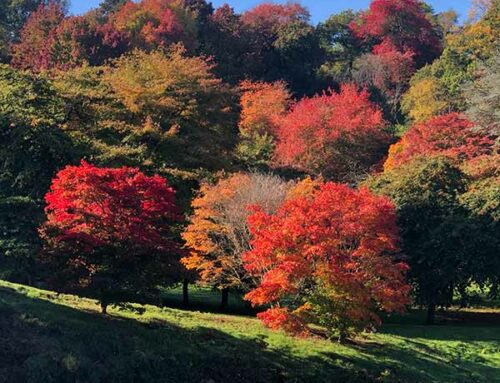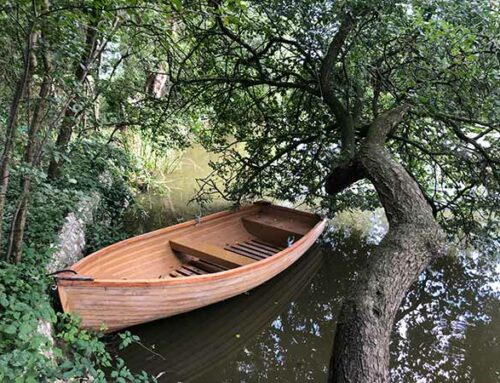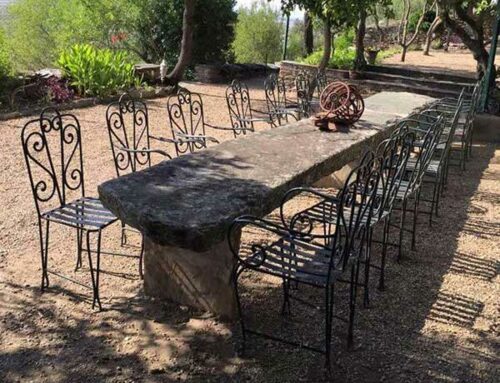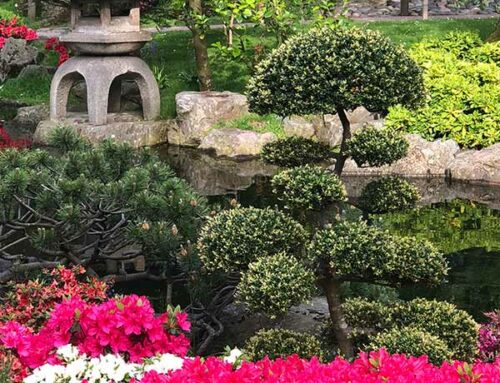We recently had the pleasure of working with garden designer Rose McMonigall to supply plants for her 2019 exotic garden entry at the RHS Hampton Court Palace Flower Show.
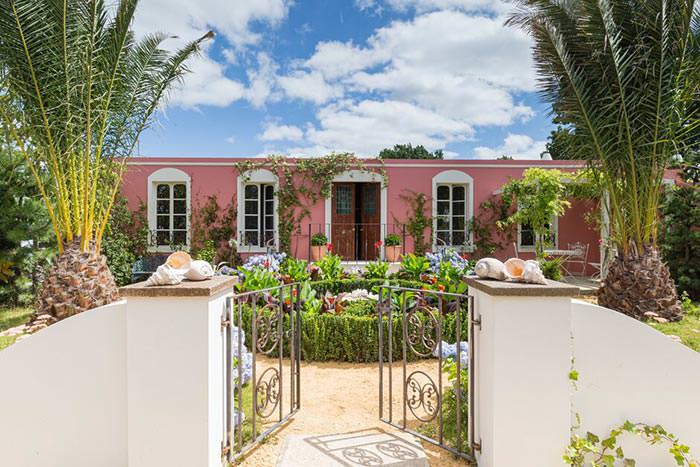
Frontal View of the tropical garden showing the house façade, euonymus parterre and the phoenix palms
Sponsored by Turismo de Galicia and the Spanish Tourist Office, the Dream of The Indianos Garden is a tribute to 19th Century Galician emigrants to the Americas who in later years returned to their beloved Galicia having amassed huge fortunes abroad. Once back home, they left a lasting mark on their local landscape by building flamboyant new palaces with tropical-style gardens full of exotic plants. They contributed significantly to local cultural and economic development by financing schools, hospitals and infrastructure.
Many congratulations to Rose McMonigall & team! The garden was deservedly awarded a silver medal at the Hampton Garden Show 2019. It’s an inspirational space that evokes the lavish colonial past. It has a tropical and lush feel throughout and cleverly combines both exotic and traditional Galician planting to create a vibrant, colourful oasis.
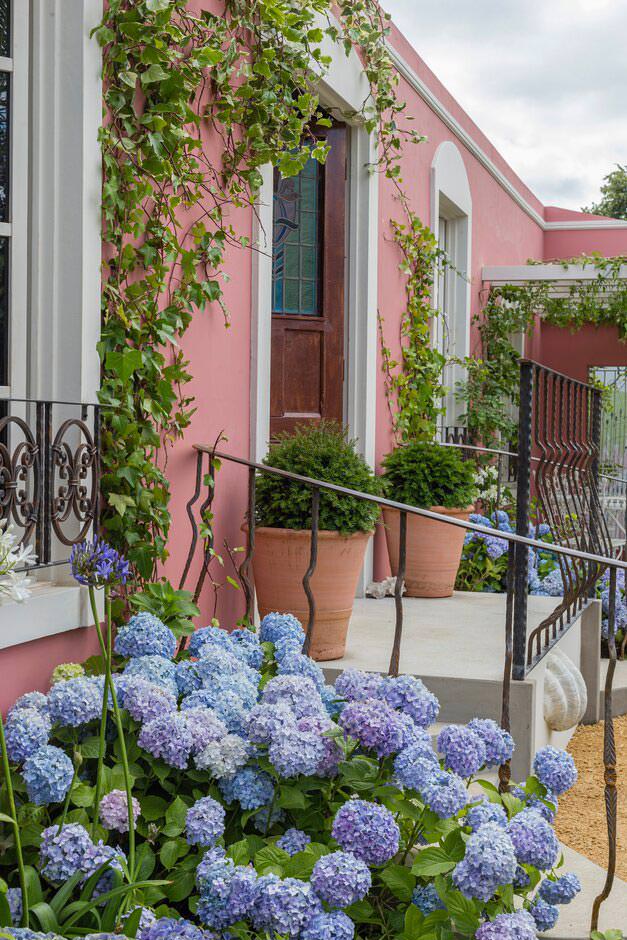
The blue of the hydrangeas contrast with the pink façade and the green foliage
A historical perspective
Los Indianos is the colloquial term for young Spaniards emigrating to the Americas in the 1800s only to return to their homelands with extraordinary wealth. They became local leaders who were very involved in their local communities. They supported charitable and cultural institutions, subsidizing the construction of schools, churches and town halls. They also contributed to building and repairing roads, hospitals, asylums and utilities.
Los Indianos were generally ambitious young people who tended to live in regions with easy access to the sea, such as Galicia. Due to poor prospects in their native lands, they had no alternative but to embark on what was known at the time as Doing the Americas in search of a better future. They mainly went to Argentina, Brazil, Cuba, Chile or Venezuela. So abundant was the Galician emigration to Argentina in particular, that the epithet Galician or Gallegos refers to any Spaniard, whatever their regional origin.
Once back home, Los Indianos sought to gain prestige by acquiring aristocratic titles, buying and restoring old mansions and building new statement homes locally referred to Casas de Indianos. These palatial homes were influenced by the exotic architectural styles of cities such as Buenos Aires or Havana. Many examples of Casas de Indianos and their decidedly flamboyant gardens can be found throughout Galicia today in towns such as Ribadeo, Ares, Fene and many more.
Los Indianos Inspiration
The young Indianos worked hard and dreamed big! The ultimate dream was to return to Galicia and build a showcase mansion and garden leaving a permanent legacy for future generations in their beloved Galician homeland. Rose McMonigall’s garden is a tribute to this.
Gardens of the Indianos were particularly inspiring introducing the local Galicians to the exotic plants of the Americas, very often for the first time. Until then, locals were unacquainted with palm trees and succulents such as Agave.
The Garden
The Dream of the Indianos garden has a colonial air about it with a geometric balance and a strong tropical feel. A flamboyant pink colonial-style façade presents the backdrop to the garden with a semi-formal parterre circle containing a water feature. The front façade of the Casa is softened with Boston Ivy and Jasmine.
Two signature mature Phoenix Palms (Phoenix Canariensis) flank either side of the parterre leaving the visitor in little doubt as to the tropical theme.
Other tropical palms populating the garden include Chamaerops Humilis Vulcano and Trachycarpus Fortunei Chusan Palm. Other hardy tropicals include Yucca Rostrata Blue Swan, Agave Americana and both blue and white Agapanthus.
The tropical planting is counter-balanced and softened using more traditional Galician planting in acknowledgement of the Pazo garden. A Pazo is Galician version of a manor house. Pazos were of crucial importance in the 17th to 19th centuries. The traditional Pazo gardens tended to be a balance of formal and romantic. Green foliage was a feature in its many shades, offset by coolly contrasting blues and lots of Camellias. Euonymus Jean Hughes was used for the parterre and characteristic mop-head hydrangeas provide the blue. Camellias (in this case Camellia Japonica Sarah Frost) are a must and featured heavily in every Pazo garden. Galicia has the ideal climate & soil conditions for growing camellias which were first brought to Galicia in the late 18th Century by Portuguese sailors.
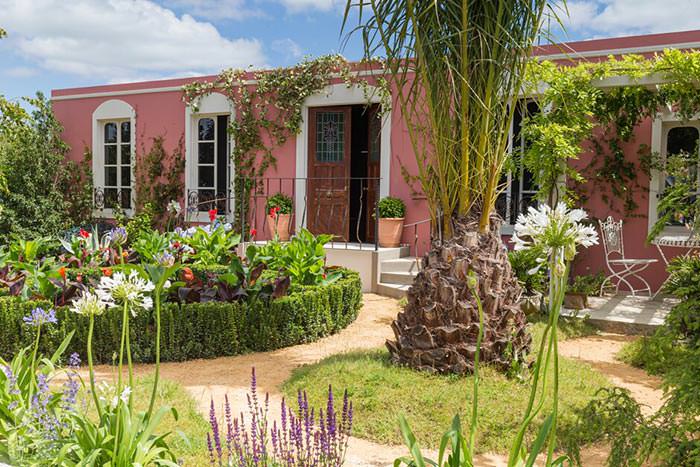
Wisteria shades the seating area in the exotic Dream of The Indianos Garden
A faded stone statue is surrounded with jasmine and an evergreen conifer. Wisteria Floribunda Alba graces the seating area. Others climbers used include Vitis Vinifera Blanc Vine and Hedera Helix Ivy.
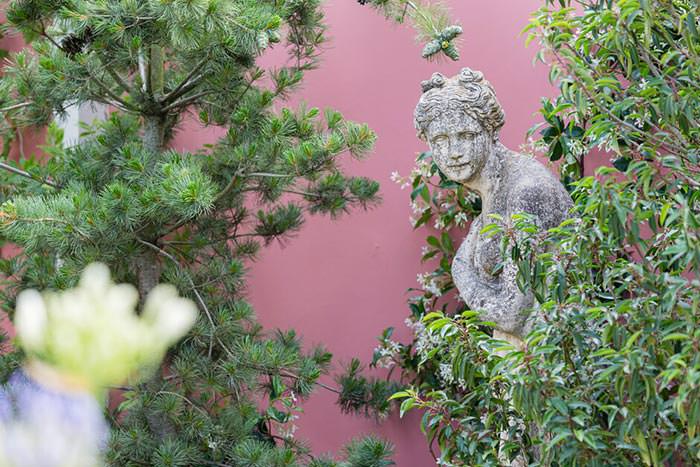
Evergreen conifers and climbers soften the stone statue in the Dream of The Indianos Garden
The garden also features Araucaria Araucana Monkey Puzzle Tree, Acacia Dealbata Mimosa, Cedrus Atlantica Glauca Blue Atlas Cedar, Pinus Nigra Austriaca Black Pine, Hornbeam Carpinus Betulus and a Tempelhof Pine.
Additional plant structure was provided by Aesculus Carnea Briotii Red Horse Chestnut in a full standard shape. Also, a pair of Fagus Sylvatica Dawyck Purple Beech and Tilia Europaea Euchlora Crimean Lime added contrasting foliage colour.
While flamboyant and tropical in style, this garden uses mainly plants which will thrive in our UK climate, which is quite similar to that of Galicia by the way. So, take inspiration and recreate the look in your own outside space.
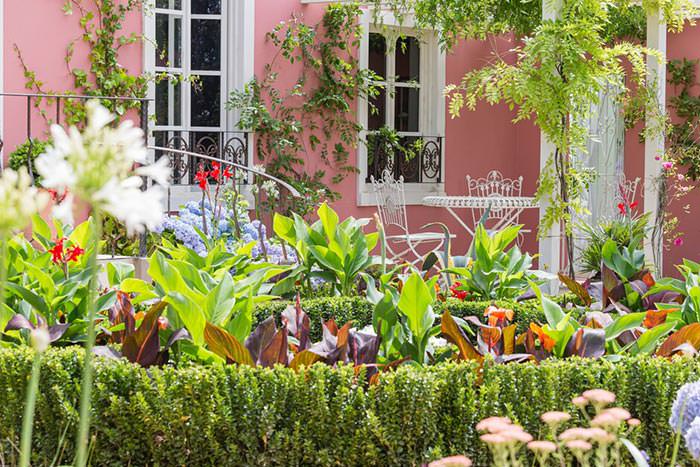
Dream of The Indianos – Tropical inspired garden designed by Rose McMonigall
All images for this feature are reproduced courtesy of RHS Hampton Court Palace Garden Festival 2019. All photos are copyright of the RHS. Photographs by Neil Hepworth.
Further Inspiration:
Galicia Related:
Take the Route of the Camelias through Galicia
Create Your Own Pazo Garden
Tropical Related:
Exotic Evergreens
Hardy Palms for UK Gardens
A Hardy Tropical Garden in Leeds
Historic Related:
Camellias in Britain – an informal history

